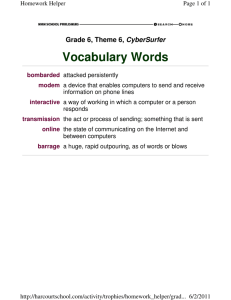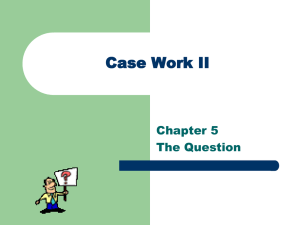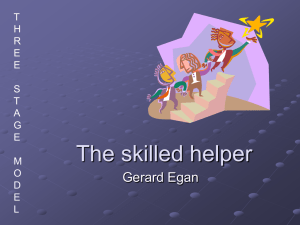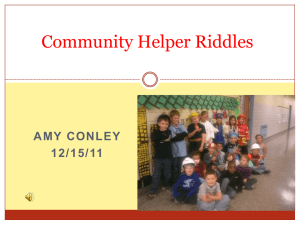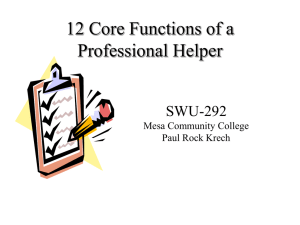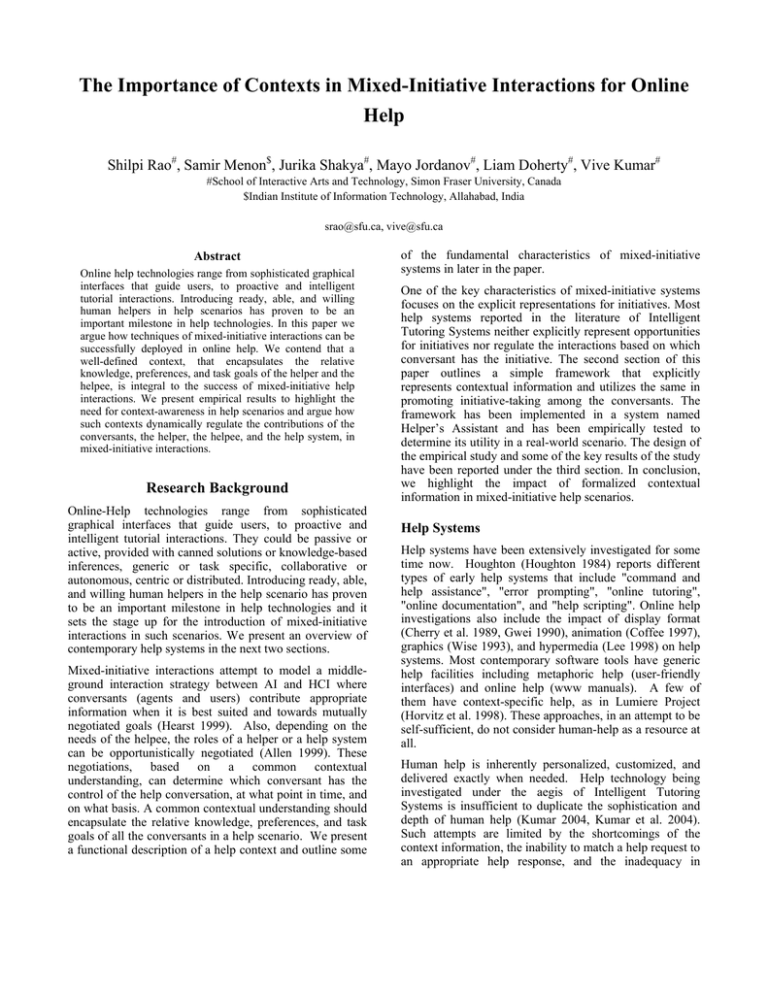
The Importance of Contexts in Mixed-Initiative Interactions for Online
Help
Shilpi Rao#, Samir Menon$, Jurika Shakya#, Mayo Jordanov#, Liam Doherty#, Vive Kumar#
#School of Interactive Arts and Technology, Simon Fraser University, Canada
$Indian Institute of Information Technology, Allahabad, India
srao@sfu.ca, vive@sfu.ca
Abstract
Online help technologies range from sophisticated graphical
interfaces that guide users, to proactive and intelligent
tutorial interactions. Introducing ready, able, and willing
human helpers in help scenarios has proven to be an
important milestone in help technologies. In this paper we
argue how techniques of mixed-initiative interactions can be
successfully deployed in online help. We contend that a
well-defined context, that encapsulates the relative
knowledge, preferences, and task goals of the helper and the
helpee, is integral to the success of mixed-initiative help
interactions. We present empirical results to highlight the
need for context-awareness in help scenarios and argue how
such contexts dynamically regulate the contributions of the
conversants, the helper, the helpee, and the help system, in
mixed-initiative interactions.
Research Background
Online-Help technologies range from sophisticated
graphical interfaces that guide users, to proactive and
intelligent tutorial interactions. They could be passive or
active, provided with canned solutions or knowledge-based
inferences, generic or task specific, collaborative or
autonomous, centric or distributed. Introducing ready, able,
and willing human helpers in the help scenario has proven
to be an important milestone in help technologies and it
sets the stage up for the introduction of mixed-initiative
interactions in such scenarios. We present an overview of
contemporary help systems in the next two sections.
Mixed-initiative interactions attempt to model a middleground interaction strategy between AI and HCI where
conversants (agents and users) contribute appropriate
information when it is best suited and towards mutually
negotiated goals (Hearst 1999). Also, depending on the
needs of the helpee, the roles of a helper or a help system
can be opportunistically negotiated (Allen 1999). These
negotiations, based on a common contextual
understanding, can determine which conversant has the
control of the help conversation, at what point in time, and
on what basis. A common contextual understanding should
encapsulate the relative knowledge, preferences, and task
goals of all the conversants in a help scenario. We present
a functional description of a help context and outline some
of the fundamental characteristics of mixed-initiative
systems in later in the paper.
One of the key characteristics of mixed-initiative systems
focuses on the explicit representations for initiatives. Most
help systems reported in the literature of Intelligent
Tutoring Systems neither explicitly represent opportunities
for initiatives nor regulate the interactions based on which
conversant has the initiative. The second section of this
paper outlines a simple framework that explicitly
represents contextual information and utilizes the same in
promoting initiative-taking among the conversants. The
framework has been implemented in a system named
Helper’s Assistant and has been empirically tested to
determine its utility in a real-world scenario. The design of
the empirical study and some of the key results of the study
have been reported under the third section. In conclusion,
we highlight the impact of formalized contextual
information in mixed-initiative help scenarios.
Help Systems
Help systems have been extensively investigated for some
time now. Houghton (Houghton 1984) reports different
types of early help systems that include "command and
help assistance", "error prompting", "online tutoring",
"online documentation", and "help scripting". Online help
investigations also include the impact of display format
(Cherry et al. 1989, Gwei 1990), animation (Coffee 1997),
graphics (Wise 1993), and hypermedia (Lee 1998) on help
systems. Most contemporary software tools have generic
help facilities including metaphoric help (user-friendly
interfaces) and online help (www manuals). A few of
them have context-specific help, as in Lumiere Project
(Horvitz et al. 1998). These approaches, in an attempt to be
self-sufficient, do not consider human-help as a resource at
all.
Human help is inherently personalized, customized, and
delivered exactly when needed. Help technology being
investigated under the aegis of Intelligent Tutoring
Systems is insufficient to duplicate the sophistication and
depth of human help (Kumar 2004, Kumar et al. 2004).
Such attempts are limited by the shortcomings of the
context information, the inability to match a help request to
an appropriate help response, and the inadequacy in
meeting time limitations. An ideal system would attempt to
store or generate vast amounts of situated and
individualized help information and to provide fast and
structured access to it. Yet, such an approach introduces
unmanageable computational complexity, inadequate
failure handling, deficient self-improvement, and inflexible
generalization.
These shortcomings have been addressed to a greater
extent in recent help systems where human helpers are
introduced as an integral part of the help system (Collins et
al. 1997, Greer et al. 1998), aptly named Human-In-TheLoop approach. A typical help scenario involves a user and
the help system, where help is delivered thorough a dialog
between the user and the help system. The human-in-theloop approach brings in human helpers to complement the
system. A helpee consumes help and a helper provides
help. Adding a human helper to the mix can buttress the
help system when it fails. This can be particularly
beneficial if the conversations among the helper, the
helpee, and the help system are dynamically regulated
based on the principles of mixed-initiative interactions.
Human-in-the-loop
Human help is superior to machine help as long as the
helper is competent and pertinent context is established
between the person delivering help and the person
receiving help. This is true because human helpers
understand subtle contextual cues better than any help
system and identify and deliver help responses within a
reasonable time limit. Successful peer help among friends
and colleagues is due to the establishment of personal
context. A context is a shared understanding of the help
requirement. Establishing a suitable context is the heart of
the problem in machine help.
Kumar (Kumar 2001) explores techniques and interfaces to
support the human helper who has been embedded in a
human-computer help environment, where the design of
the help system is capable of acquiring context
information, making useful knowledge-based help
responses, and ensuring delivery of help within acceptable
time limits. Human-in-the-loop approach, aided by taskspecific user-centric contexts, can assist the development
of a pragmatic help system that is intelligent, informed of
the user, informed of the tasks involved, informed of the
information used, informed of the collaborative
interactions, and informed of the help resources.
Contexts
Most contemporary help systems are content-rich and
context-poor. That is, a help request can be resolved using
a variety of information and tools, hence content-rich, but
it is a difficult problem to deliver the help in a personalized
fashion target to the user’s needs, hence context-poor.
A context gives depth to information using which a help
context facilitates the helper and the helpee to interact in a
congenial fashion. Information contained within a context
is, in most cases, localized. That is, the context information
from one help session may not be relevant in another help
session. Context information can be used during a help
session in a variety of ways: to verify the suitability of the
helper-helpee pair; to find out how much time the helper
would like to help in a help session; to suggest help tools
that the helpee would like to use; to suggest pedagogy (as
part of the delivery of instructional strategies) that the
helpee is comfortable with; to categorize the helper and the
helpee in terms of their conceptual knowledge; and so on.
Essentially, the context is used to ensure the success of the
three-way dialogue between the helper, the helpee, and the
help system.
Typical help contexts contain information including
ontological relationships among context elements,
instantiated knowledgebase about the users, inference rules
pertaining to the help request, the concepts addressed by
the help request, the tasks of the helpee related to the help
request, the preferences of the helpee, the helper, and the
system, and finally a set of instantiated plans pertaining to
the current help session.
Mixed-Initiative Interactions
In a typical help-oriented interface, we find either an
approach where agents instigate and control interactions
through software mechanisms, or an approach where
humans instigate and control interactions through direct
manipulation. Mixed-Initiative refers to a flexible
interaction strategy, where each agent can contribute to the
task what it does best (Allen 1999). Specific mechanisms
of mixed-initiatives such turn taking, grounding,
confirmation,
misrecognition
repair,
automation
awareness, and attention management are used to interpret
the conversants’ objectives and establish a context.
Recently, there has been a newly found interest among
researchers in combining automation with human values –
“to seek valuable synergies between the two areas of
investigation…to avoid building complex reasoning
machinery to patch fundamentally poor designs and
metaphors…to avoid limiting designs for human-computer
interaction to direct manipulation when significant power
and efficiencies can be gained with automated reasoning”
(Horvitz 1999).
At any one time, one conversant might have the initiative controlling the interaction - while others work to assist it,
contributing to the interaction as required. At other times,
the roles can be reversed, or the conversants might be
working independently, assisting each other only when
specifically asked. In our view, mixed-initiative
interactions are driven by conversants’ relative knowledge,
preferences, and task-specific toward common, partially
shared, and individual goals.
We further constrain the contributions of interaction of the
conversants’ in terms of theory-oriented interaction
models. That is, each utterance from a conversant should
be interpreted and recognized within the scope of an
interaction model. This allows us not only to trace mixedinitiative interactions in a theoretical framework but also
verifies the validity of the theoretical foundation of the
interaction model. We also contend that mixed-initiative
interactions bring forth a sense of naturalness to the
communication among the conversants that fosters healthy
interactions among socially-oriented contexts such as
‘hallway chat’ or ‘homework’ interactions as depicted in
(Rowson 2001). Importantly, mixed-initiative interactions
enable a more accurate conceptualization of the relation
between conversant interactions and the underlying
cognitive, meta-cognitive, and socio-cognitive strategies
employed by the conversants.
The advantages of using mixed-initiative interactions in
problem-solving environments have been reported (Guinn
1993, Guinn 1996). Horvitz et al. (Horvitz 1999) elaborate
on mixed-initiative interactions in LookOut, an interface
for calendar scheduling that automatically extracts email
information and updates a person’s calendar. In doing so, it
establishes a context around beliefs about a user’s goals. In
addition, LookOut also allows the user to directly
manipulate the calendar. Personalized mixed-initiative
interactions have also been investigated with the system
learning from the contexts used by humans (Glass 2003).
The modification of the system’s vocabulary during user
interactions could lead to highly personalized interaction
mechanisms.
We have developed an ontology-oriented framework,
called MI-EDNA, for mixed-initiative interactions and are
currently in the process of validating the framework in the
domain of reading (Shakya 2005). The framework consists
of an ontology that represents information pertaining to
content, learner, time, and interactions. Interactions of the
conversants are automatically instantiated in the ontology.
Further, patterns of specific tactics, strategies, and styles
are recognized from the instantiated ontology. The
recognized interactions, tactics, strategies, and styles, in an
increasing order of granularity, are then mapped onto
formal theoretical models (e.g., Zimmerman’s 3-phase
model of Self-Regulated Learning). The framework then
advocates opportunities to disseminate ‘well founded’
prompts and other feedback mechanism to regulate the
interactions among the conversants.
In this paper, we describe our reasoning in employing the
MI-EDNA framework within a prototype help system
named Helper’s Assistant. Helper’s Assistant explicitly
represents contexts that can be used by all the conversants
(Kumar 2001). We propose to extend the scope of the
context to include variables that are relevant for mixedinitiative interactions.
Our discussion so far has focused on online help in
educational systems and identified contexts as an integral
component of learning technologies. In the next section we
describe how contexts are employed in Helper’s Assistant.
Help-context in Helper’s Assistant
Helper’s Assistant is a support tool for helpers in the
domain of Java programming. A help-request originating
from a helpee initiates the help session and the help
context.
A help-context is construed as an extended representation
of a help request and is a container for resources relevant
for the help request. The context also includes summaries
of help sessions that the helpee and the helper went
through based on the feedback and commentaries the
system collects from the conversants at the end of each
help session.
Typically, a helpee creates a help-request that contains a
question, an expected type of response, and the
corresponding material (such as a piece of Java code). In
addition, the help request may also map onto a set of
concepts in a concept map and associated keywords. In
turn, each instantiated concepts and keywords is associated
with the knowledge/skill levels of the helper and the
helpee.
The context also identifies a list of tasks that the helpee is
currently engaged in. For instance, “assignment
submission”, “exams”, “in-class discussions”, and
“quizzes”, are some example tasks. Corresponding to each
task, the context instantiates task models that capture the
procedural knowledge associated with a task.
The help-context in Helper’s Assistant also records/infers
preferences of the conversants with respect to the type of
help responses, the mode of help-delivery, and the form of
help communication. Some example help response types
are, debugging, pointer, short answer, discussion,
explanation, analogy, rebuke, need more information,
delay response, and provide clues. Helper can interact in
three pre-defined modes in Helper’s Assistant: offline,
online, and just-in-time.
Offline help involves
asynchronous communication between the helpee and the
helper using email or discussion boards as the media.
Online help involves the helper sharing the helpee’s
workspace (or the communication channel) and helping
him/her step through an on-going task. That is, the helper
remains available for the duration of the task. In the justin-time mode, help is highly specific to the question raised
by the helpee and is delivered in short bursts.
The helper predominantly decides the form of the help
response, either manual or automated. However, the
helpee and the system can propose/negotiate their
respective preferences for the consideration of the helper.
In the manual form of help, communication tools and
interfaces are established between the helpee and the
helper so that the helper can manually (personally) deliver
help using these tools and interfaces. In the automated
form of help, Helper’s Assistant provides the necessary
help documents and help procedures to the helper who then
verifies the help material and lets the system deliver the
same to the helpee without any further involvement from
the helper.
A help-context is created for every help session in Helper’s
Assistant. Each help-context is classified into a type in
order to associate the effectiveness of a help session with
the help-context. The type of the help-context is a
summarization (or a signature) of help-context data
deduced only from the instantiated concepts, and the
preferences of the helpee, helper, and the system.
Help Assistant Analysis
80
70
60
50
40
30
20
The help requests originated from two pre-assigned
helpees. The helpees were trained to ask a specific set of
questions corresponding to the four help requests. Each
helper was blinded from the helpees and also from other
helpers. Essentially, each helper was led to believe that the
help requests and the follow-up questions were coming
from real learners.
The interactions of the helper and the helpee were video
taped. The mouse clicks, keyboard button pushes, and
browsing patterns of the helpers across different
applications were also recorded and time-stamped. In
addition, each helper and helpee was asked to complete a
questionnaire at the end of each help session and also
provide overall feedback. The dialogues between the
helper and the helpee were encoded independently by an
external evaluator. Refer to (Kumar 2001) for a complete
analysis of the study.
Based on the questionnaire data, as depicted in Figure 1,
we observed that, both experts (56%) and novice peers
(72%) are happy with the contextual information provided
by Helper’s Assistant. 25% of experts and 75% novice
peers said that they were satisfied with the quality of
pedagogical strategies. That is, novice peers preferred to
have additional contextual support with respect to
pedagogical strategies.
Expert User
Satisfaction
10
0
Contextual
information provided
Experimental Results
An empirical study was conducted with the goal of
estimating the effectiveness of help sessions with and
without Helper’s Assistant, among expert (teaching
assistants) and peer helpers (novices). Each helper
responded to four help requests, handling two requests
with assistance from Helper’s Assistant and two without.
The help requests were derived from four buggy Java
solutions to an introductory programming problem.
Novice User
Satisfaction
Quality of
pedagogical
strategies
Figure 1: Helper satisfaction
The questionnaire did not probe the issue of whether
experts found the pedagogical strategies less attractive
because they would have preferred other strategies or they
did not like strategy-oriented advice from the system.
Based on the questionnaire data, as depicted in Figure 2,
we find that experts engaged in successful help sessions
88% of the time with contextual information and 85% of
the time without contextual information. On the other
hand, novice users had success rates of 87% and 63%
respectively. Thus, novice peers find the availability of
contextual information to be more useful in successfully
negotiating a help session than experts did.
Question and Answer Test
100
90
80
70
60
50
40
30
20
10
0
With Help
Assistant
Without Help
Assistant
Novice Success
Percentage
Expert Success
Percentage
Figure 2: Helper Success Percentage
Using Wilcoxon rank-sum test (or Wilcoxon two-sample
test), it was determined that there is no significant
difference in the success percentage of experts between
sessions with contextual information and without
contextual information. On the other hand, using Wilcoxon
signed-Rank test for paired observations and Wilcoxon
rank-sum test, at the α = 0.1 level, it was determined that
there are differences in the medians of the success
percentages of the novice peer helpers between sessions
with contextual information and without contextual
information.
With respect to questionnaire related to cognitive load,
none of the experts felt that the contextual information
provided by Helper’s Assistant was too complicated to use,
as opposed to, every novice peer helpers who found
contextual information too complicated to use. Only one
expert and one novice peer helper concurred that the
context provided too much information. Two experts and
three novices agreed on a midway, while all the experts
and novice peer helpers said that the context provided too
much information.
In general, expert helpers seemed to view the context as a
reasonable tool to use with respect to complexity of use,
overload of information, and ease of use in conjunction
with other tools, while novice peer helpers seemed more
apprehensive.
One of the key results obtained from the experiment deals
with “speed of help response”. A help request is assumed
to have been addressed when the helper starts to “direct
his/her responses” towards answering the help request. In
most cases, the helpee would initiate a request, the helper
would ask for some clarification, and finally the helper
would start giving answers. The time interval between the
start of a help request (from the helpee) to the start of the
first help response utterance (from the helper) is treated as
a measure of speed with which help can be offered. That is,
this is the amount of time taken by the helpers to
comprehend the question and initiate their responses.
All expert helpers (except one) consistently showed that
they were able to provide help faster when the help system
was available. Even for the odd expert helper who took
more time to start providing help when the help system
was made available, the difference between context
establishment time is quite small (8:41 vs 9:03 minutes).
All novice helpers consistently showed that they were able
to provide help faster when the contextual information was
made available.
Using, Wilcoxon rank-sum test, it has been observed that
there is no significant difference in the average context
establishment times of the expert helpers between sessions
with and without contextual information. However, using
the same non-parametric statistical test, at the α = 0.1
level, it has been determined that there is significant
difference in the speed of help response of the novice peer
helpers between sessions with and without contextual
information.
Conclusions
Based on the results from the study we emphasize the need
for an explicit representation of the context for use by the
conversants of the help environment. The current
contextual representation of Helper’s Assistant can be
improvised to include variables associated with mixedinitiative interactions. For instance, the help-contexts can
include which of the conversant is currently in control of
the interactions and why; the help-context can advice
whether a particular type, mode, or form of help interaction
is beneficial; the help-context can facilitate negotiation
among the conversants with respect to preferences and the
degree of contextual use; the help-context can trace
interactions with respect to specific theories of academic
help seeking (Nelson-LeGall 1981, Newman 1994,
Newman 2002) the help-context can suggest specific goals
to pursue with respect to factual, procedural, and
conditional knowledge; the help-context can negotiate with
the helper on the effective use of working-memory; and,
the help-context can estimate values for commitment,
attitude, attention, and motivation of conversants.
We believe that mixed-initiative interactions, when
incorporated into an online help system, allow for much
greater personalization as long as the interactions are
tracked and regulated with respect to specific theoretical
models that employ contextual information.
Judging by how helpful the contextual information was to
novice helpers, we believe that a mixed-initiative approach
has good potential to improvise the help process, to
increase the success rate and quality of the help sessions,
and to create a much better understanding among the
conversants.
Acknowledgments
This research was funded by the LearningKit project
(SSHRC-INE) and the LORNET project (NSERC).
Copyright
Copyright 2005, American Association for Artificial
Intelligence. All rights reserved. http://www.aaai.org.
References
Allen J. F. September 1999. Mixed-initiative interaction.
IEEE Intelligent Systems, 14-16.
Cherry, J., Fryer, B.., Steckham, M., & Fischer, M. 1989.
Do formats for presenting online help affect user
performance
and
attitudes?.Proceedings
of
the
International Technical Communication Conference
Washington, DC: Society of Technical Communication. pp.
RET87- RET89.
Coffee P. 1997. Office Assistant is - surprise! - useful. PC
Week, 14(3), 49.
Collins J.A., Greer J.E., Kumar V.S., McCalla G.I.,
Meagher P., & Tkatch R. 1997. Inspectable user models
for just-in-time workplace training. The Sixth International
Conference on User Modeling (UM'97). Chia Laguna,
Sardinia, Italy, 327-337.
Glass. J, Seneff. S. 2003. “Flexible and Personalizable
Mixed-Initiative Dialogue Systems”. HLT-NAACL 2003
Workshop on Research Directions in Dialogue.
Greer J.E., McCalla G.I., Cooke J., Collins J., Kumar V.S.,
Bishop A., & Vassileva J.I. 1998. The intelligent helpdesk:
Supporting peer-help in a university course. The
International Conference on Intelligent Tutoring Systems
(ITS'98). San Antonio, TX, USA, 494-503.
Newman, R. 1994. Adaptive help seeking: A strategy of
self-regulated learning. In D.H. Schunk & B.J.
Zimmerman (Eds.), Self-regulation of learning and
performance: Issues and educational applications (283301) Hillsdale, NJ: Lawrence Erlbaum Associates.
Greer, J.E., McCalla, G.I., Collins, J.A., Kumar, V.S.,
Meagher, P. and Vassileva, J.I. 1998. Supporting Peer Help
and Collaboration in Distributed Workplace Environments.
International Journal of Artificial Intelligence in
Education V. 9, 159-177.
Newman, R. Spring 2002. How self-regulated learners
cope with academic difficulty: the role of adaptive help
seeking. In Theory Into Practice, Vol 41, Number 2.
Guinn C. March 1993. Efficient Collaborative Discourse:
A Theory and its Implementation, with Alan Biermann, D.
Richard Hipp, and Ronnie Smith in ARPA Workshop on
Human Language Technology, Princeton, NJ.
Guinn C. 1996. Mechanisms for Mixed-Initiative HumanComputer Collaborative Discourse, in Proceedings of the
34th Annual Meeting of the Association for Computational
Linguistics.
Gwei G.M., & Foxley E. 1990. Towards a consultative online help system. International journal of man machine
studies, 32(4), 363-383.
Hearst, M. September/October 1999. Mixed-Initiative
Interaction. IEEE Intelligent Systems, vol. 14, no. 5, 1423.
Horwitz E. September 1999. Uncertainty, action, and
interaction: In pursuit of mixed initiative computing”.
IEEE Intelligent Systems, 17-20.
Horvitz, E., Breese, J.S., Heckerman, D., Hovel, D.,
Rommelse, K. 1998. The Lumiere Project: Bayesian user
modeling for inferring the goals and needs of software
users. Fourteenth Conference on Uncertainty in Artificial
Intelligence. Morgan Kaufmann Publishers. 256-265.
http://research.microsoft.com/~horvitz/lumiere.htm.
Houghton R.C., Jr. 1984. “Online Help Systems: A
Conspectus”. Communications of the ACM, 27, 2, 126–
133.
Kumar, V. 2001. Helping the helper in peer help networks.
PhD Thesis, Department of Computer Science, University
of Saskatchewan, Canada.
Kumar, V. Shakya, J. Groeneboer, C. Chu, S. August 2004.
Toward an ontology of teaching strategies. Workshop
Paper in ITS2004, Brazil.
Kumar, V. 2004. An Instrument for providing formative
feedback to novice programmers. AERA 2004 Division I
Education in the professions. San Diego, USA.
Lee. H, Lee. C, Yoo. C. 1998. "A Scenario-Based ObjectOriented Methodology for Developing Hypermedia
Information Systems," hicss, vol. 2, no. 2, 47.
Nelson-Le Gall, S. 1981. Help-seeking: An understudied
problem-solving skill in children. Developmental Review,
1, 224-246.
Rowson, J. November 2001. The Social Media Project at
Hewlett Packard Laboratories. Talk at the Stanford
Networking Seminar of Center for the Study of Language
and
Information
(CSLI),
Stanford
University.
http://netseminar.stanford.edu/sessions/2001-11-01.html.
Shakya, J., Menon S., Doherty, L., Jordanov, M., Kumar
V. Accepted for publication, 2005 (in this volume).
Recognizing opportunities for mixed-initiative interactions
based on the principles of Self-Regulated Learning, AAAI
Fall Symposia on Mixed-Initiative Problem-Solving
Assistants, Crystal City, VA, USA.
Wise M. 1993. Using graphics in software documentation.
Journal of the society for technical communications, 40,
677-681.

